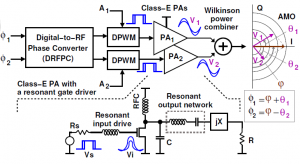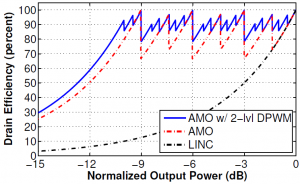Asymmetric Multilevel Outphasing Architecture for Multi-standard Transmitters

Figure 1: Asymmetric multilevel outphasing (AMO) transmitter architecture with discrete pulse width modulation (DPWM).
Wideband RF power amplifiers (PAs) with high efficiency are of great importance in high-data-rate communications. Tremendous efforts to beat the linearity-efficiency tradeoff for PAs has led to a wide variety of architectures, including polar, outphasing, envelope tracking, feedforward, Cartesian feedback, predistortion, Doherty, and RF delta-sigma modulation. Among these, outphasing architectures [1] [2] are capable of transmitting very wideband signals and are thus suitable for wideband communication in multi-standard applications. However, the power efficiency of outphasing is poor at large power back-off, which is a critical drawback for wideband signals with high peak-to-average power ratios. Multilevel Linear Amplification of Nonlinear Component (ML-LINC) [3] and Asymmetric Multilevel Outphasing (AMO) [4] transmitters improve the outphasing efficiency by switching the supplies of the PAs among a discrete set of voltages. This method allows them to minimize the occurrence of large outphasing angles.

Figure 2: Drain efficiency improvement of ideal AMO-DPWM transmitters with a 4-level supply modulator by applying 2-level DPWM.
Recently, we advanced AMO architecture by using Class-E PAs with discrete pulse width modulation (DPWM) as shown in Figure 1. DPWM improves the classical outphasing power efficiency by allowing independent, discrete envelope amplitude changes in each of the two Class-E PAs, without changes in supply voltage. In contrast, conventional RF PWM Class-E PAs continuously modulate the input duty cycle over a large range with very fine resolution. One practical problem with the conventional PWM approach is that achieving a wide dynamic range at GHz carrier frequencies requires pulse widths on the order of a few picoseconds, which are difficult to generate. Furthermore, input pulses with very low duty ratios are not processed effectively by PAs, so that the transmission of high PAPR results in poor linearity. DPWM overcomes these problems by restricting the duty cycles to a discrete set and avoiding small duty cycles [5]. Figure 2 shows simulated efficiency improvement of ideal AMO transmitters with a 4-level supply voltage modulator by applying 2-level DPWM.
References
- D. Cox, “Linear amplification with nonlinear components,” IEEE Transactions on Communications, vol. 22, no. 12, pp. 1942-1945, Dec. 1974. [↩]
- M. E. Heidari, M. Lee, and A. A. Abidi, “All digital outphasing modulator for a software-defined transmitter,” IEEE Journal of Solid State Circuits, vol. 44, no. 4, pp. 1260-1271, Apr. 2009. [↩]
- Y.-J. Chen, K.-Y. Jheng, A.-Y. Wu, H.-W. Tsao, and B. Tzeng, “Multilevel LINC system design for wireless transmitters,” International Symposium on VLSI Design, Automation, and Test, Hsinchu, Taiwan, Apr. 2007. [↩]
- S. Chung, P. A. Godoy, T. W. Barton, T. W. Huang, D. J. Perreault, J. L. Dawson, “Asymmetric multilevel outphasing architecture for multi-standard transmitters,” IEEE Symposium on Radio Frequency Integrated Circuits, Boston, MA, June 2009. [↩]
- S. Chung, P. A. Godoy, T. W. Barton, D. J. Perreault, J. L. Dawson, “Asymmetric Multilevel Outphasing Transmitter using Class-E Pas with Discrete Pulse Width Modulation,” IEEE Symposium on International Microwave Symposium, Anaheim, CA, June 2010. [↩]